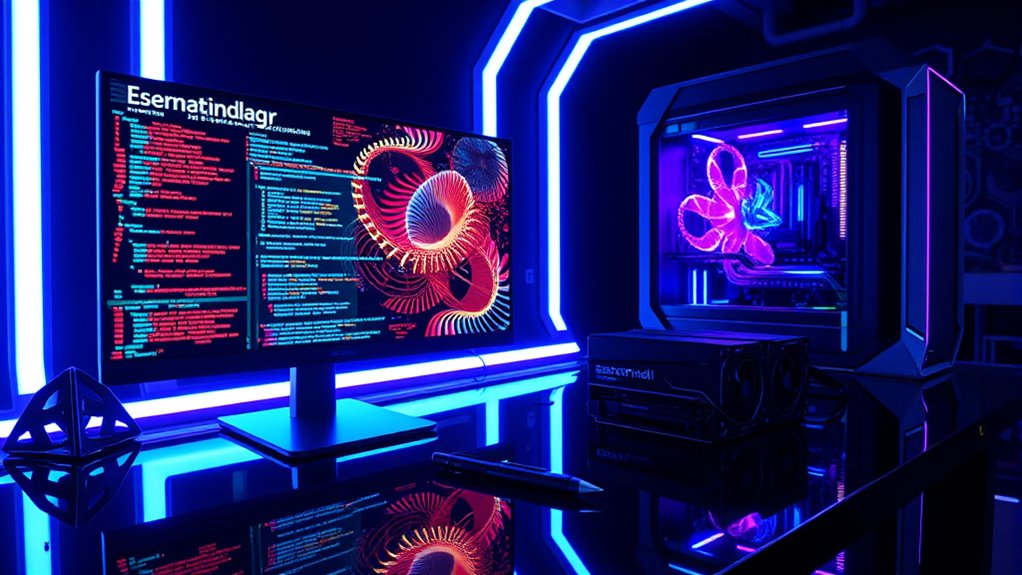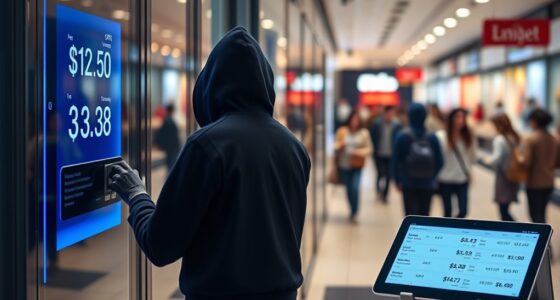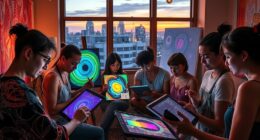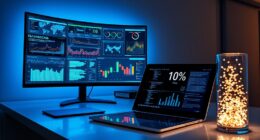AI is transforming how you generate procedural animation sequences by automating complex movements and making them more realistic. It uses algorithms, machine learning, and physics simulations to create natural interactions and adapt across different characters and environments. This reduces manual effort, speeds up production, and boosts flexibility. If you explore further, you’ll uncover how these advanced tools are shaping the future of dynamic, immersive animations.
Key Takeaways
- AI uses machine learning and generative models to create dynamic, adaptive animation sequences beyond static keyframes.
- Procedural animation sequences are generated through rules-based systems and physics simulations for realistic motion.
- AI analyzes motion datasets to produce nuanced, natural movements tailored to different characters and environments.
- Generative techniques, like GANs, automatically produce textures, backgrounds, and scene elements for seamless sequences.
- AI-driven procedural generation reduces manual effort, speeds up production, and enables more complex, immersive animations.
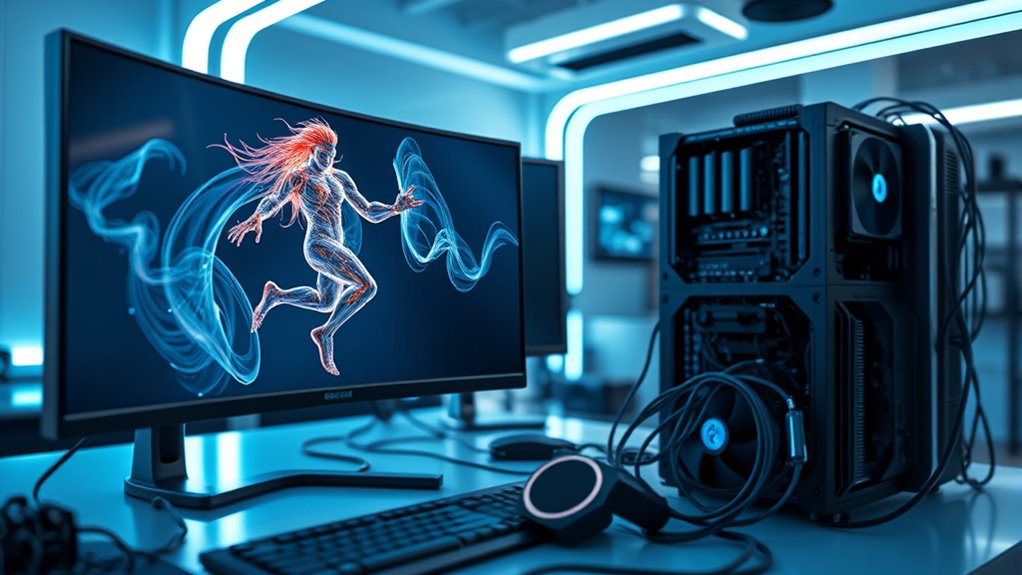
Artificial intelligence is transforming how we create procedural animation sequences by making movements more realistic, flexible, and efficient. Instead of relying solely on predefined keyframes, AI leverages algorithms and rules to generate animations dynamically, allowing for more natural interactions and behaviors. This shift means you can produce complex sequences without manually crafting every detail, saving time and resources while increasing realism. AI-driven procedural animation adapts seamlessly across different characters and environments, giving you the versatility to create varied scenes without starting from scratch each time.
AI plays a vital role in refining movements, interpolating between keyframes, and enabling realistic interactions. Machine learning models analyze vast datasets of motion data, learning the nuances of facial expressions, body language, and environmental responses. As a result, the animations generated are smoother and more lifelike. Generative Adversarial Networks (GANs) further enhance this process by creating detailed textures, backgrounds, and scene elements that blend seamlessly with the animated characters. Physics-based simulations, such as Nvidia’s PhysX, add another layer of realism by accurately modeling environmental forces like gravity, friction, and collisions, making interactions feel authentic.
Machine learning refines movement nuances, creating smoother, more lifelike animations and realistic environmental interactions through advanced data analysis.
You’ll find that IK bones—Inverse Kinematics—are instrumental in achieving natural limb movements. They allow the system to calculate joint rotations dynamically, ensuring characters move believably in response to their environment. Interpolation techniques help transition smoothly between keyframes, eliminating stiff or jerky motions and creating fluid animations. Generative models can produce intricate backgrounds or textures, enriching scenes without manual effort. Rules-based systems, meanwhile, provide a framework for controlling behaviors, ensuring characters respond consistently to environmental stimuli or narrative cues. Additionally, advancements in color accuracy and high contrast ratios further improve visual fidelity, making AI-generated content even more compelling and immersive.
The advantages of integrating AI into procedural animation are clear. It drastically improves efficiency by reducing the need for extensive manual animation labor. Animators and developers can focus more on creative aspects, knowing that AI handles routine or complex movements. The realism achieved through AI-enhanced techniques makes characters more believable, whether in games, films, or virtual environments. This flexibility allows you to adapt animations across various scenarios and character types easily, fostering innovation and experimentation. Additionally, AI-driven procedural animation is cost-effective, cutting down production time and labor costs while delivering high-quality results.
However, implementing AI isn’t without challenges. It demands sophisticated systems, large datasets for training, and significant computational power. Setting up these tools requires effort and expertise, especially when adapting to diverse character models or environments. Despite these hurdles, the continual advancement of AI technology promises even more powerful and accessible tools for procedural animation in the future. As AI capabilities grow, so will the potential for creating increasingly complex, realistic, and immersive animations that push the boundaries of digital storytelling and interactive experiences.
Frequently Asked Questions
How Does AI Improve Real-Time Animation Responsiveness?
You see, AI improves real-time animation responsiveness by analyzing motion data instantly, providing immediate feedback as you work. It automates complex tasks like character rigging and motion adjustments, so you can make quick changes without delays. This streamlines your workflow, allowing for more dynamic adjustments and lifelike animations. With AI, you get faster, more accurate responses, which helps you create smooth, realistic animations in real-time.
Can Ai-Generated Sequences Be Customized for Specific Art Styles?
Did you know that 85% of creators find AI customization tools enhance their artistic control? You can customize AI-generated sequences for specific art styles by adjusting parameters, using style transfer techniques, or inputting your own images and scripts. These tools give you flexibility, allowing you to collaborate with AI, tweak algorithms, and apply post-processing effects to match your desired aesthetic precisely. This makes your animations uniquely tailored to your artistic vision.
What Are the Limitations of AI in Complex Animations?
When tackling complex animations, you’ll find AI faces significant limitations. It struggles to maintain consistent character design, realistic physics, and natural movements. Lighting and shading often look inconsistent, and it can’t judge the artistic quality or emotional nuance. You’ll notice AI falls into repetitive patterns, blends styles awkwardly, and sometimes creates unsettling, uncanny effects. Plus, it relies heavily on human oversight, making complex projects more time-consuming and requiring costly revisions.
How Does AI Handle Unpredictable or Chaotic Motion?
You might find chaos fascinating but challenging to predict. AI handles unpredictable motion by analyzing patterns and using advanced algorithms to generate realistic, spontaneous movements. It employs noise functions, physics simulations, and neural networks to mimic chaotic behavior. With real-time data analysis and GPU acceleration, AI creates more natural, lively animations, making the unpredictable look seamless and believable, adding depth and realism to your animations without sacrificing control or detail.
What Are the Future Trends for AI in Animation Development?
You’re curious about future trends in AI for animation development. Expect AI to become more creative and intuitive, helping you design more realistic characters and immersive experiences. It’ll increasingly personalize content, adapt styles seamlessly, and generate complex animations in real-time. These advancements will streamline workflows, reduce costs, and open new creative possibilities, making your animation projects more dynamic, engaging, and efficient as AI tools evolve to support your innovative ideas.
Conclusion
So, here you are, relying on AI to craft your perfect animation sequences. Ironically, while it promises endless creativity, it often leads to predictable results or robotic motions. You might think you’re pushing the boundaries, but sometimes, AI just highlights how much human touch truly matters. In the end, technology can’t replace the artistry behind genuine animation—yet, it sure makes you wonder if the future’s just a copy-paste job.

